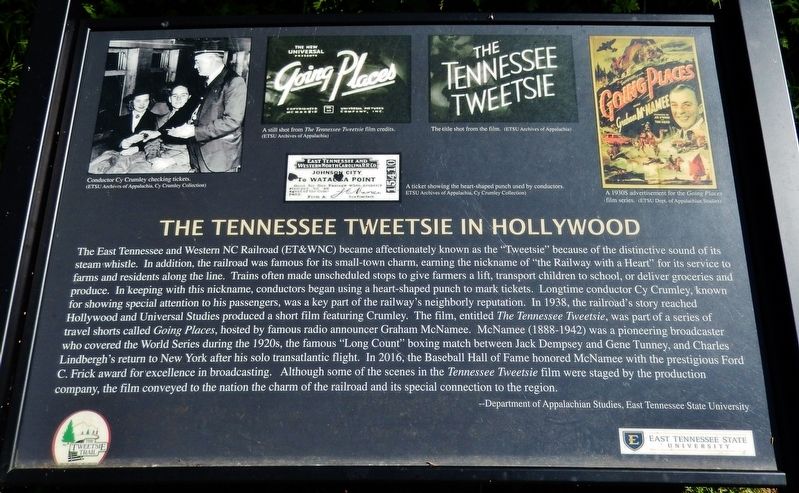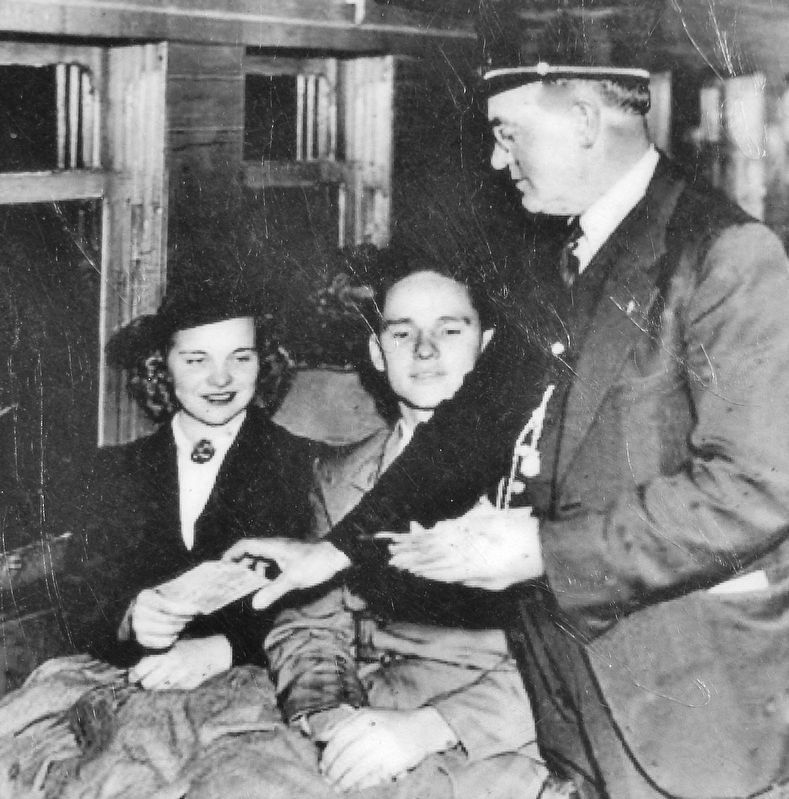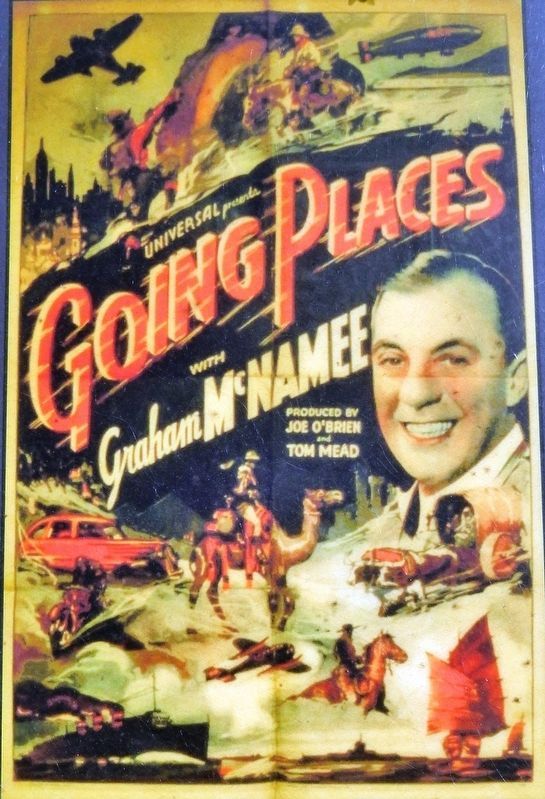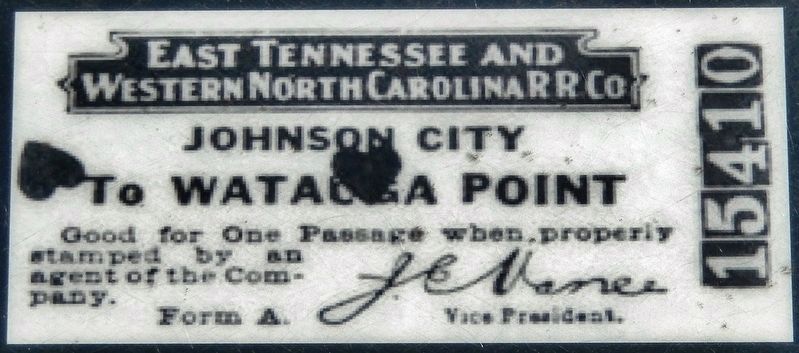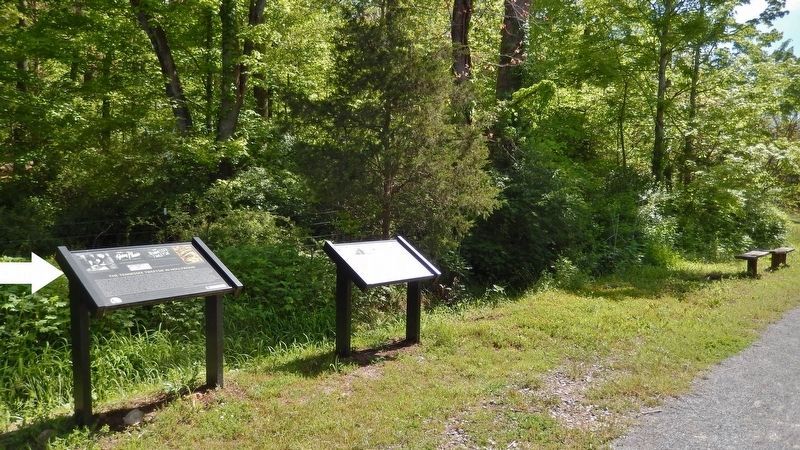Johnson City in Carter County, Tennessee — The American South (East South Central)
The Tennessee Tweetsie in Hollywood
The East Tennessee and Western NC Railroad (ET&WNC) became affectionately known as the "Tweetsie" because of the distinctive sound of its steam whistle. In addition, the railroad was famous for its small-town charm, earning the nickname of "the Railway with a Heart" for its service to farms and residents along the line. Trains often made unscheduled stops to give farmers a lift, transport children to school, or deliver groceries and produce. In keeping with this nickname, conductors began using a heart-shaped punch to mark tickets. Longtime conductor Cy Crumley, known for showing special attention to his passengers, was a key part of the railway's neighborly reputation. In 1938, the railroad's story reached Hollywood and Universal Studios produced a short film featuring Crumley. The film, entitled The Tennessee Tweetsie, was part of a series of travel shorts called Going Places, hosted by famous radio announcer Graham McNamee. McNamee (1888-1942) was a pioneering broadcaster who covered the World Series during the 1920s, the famous "Long Count" boxing match between Jack Dempsey and Gene Tunney, and Charles Lindbergh's return to New York after his solo transatlantic flight. In 2016, the Baseball Hall of Fame honored McNamee with the prestigious Ford C. Frick award for excellence in broadcasting. Although some of the scenes in the Tennessee Tweetsie film were staged by the production company, the film conveyed to the nation the charm of the railroad and its special connection to the region.
—Department of Appalachian Studies, East Tennessee State University
Erected by Department of Appalachian Studies, East Tennessee State University.
Topics. This historical marker is listed in these topic lists: Entertainment • Railroads & Streetcars • Sports. A significant historical year for this entry is 1938.
Location. 36° 18.596′ N, 82° 17.925′ W. Marker is in Johnson City, Tennessee, in Carter County. Marker can be reached from the intersection of Greenlee Road and Cedar Grove Road, on the right when traveling north. Marker is located on the Tweetsie Trail, ¼ mile east of Greenlee Road. Touch for map. Marker is in this post office area: Johnson City TN 37601, United States of America. Touch for directions.
Other nearby markers. At least 8 other markers are within 2 miles of this marker, measured as the crow flies. Gandy Dancers (here, next to this marker); Milligan Depot (approx. 0.3 miles away); Milligan College (approx. 0.6 miles away); Cranberry Furnace Company Quarry (approx. 0.6 miles away); Constructing a Mountain Railroad (approx. 0.6 miles away); Hauling Ore from the Cranberry Mine (approx. 0.6 miles away);
Williams-Taylor House (approx. 0.9 miles away); The Robertson Home, Site of First Court of Washington County (approx. 1.1 miles away). Touch for a list and map of all markers in Johnson City.
More about this marker. Access to this marker is via bicycle or foot on the Tweetsie Trail.
Also see . . .
1. The Cy Crumley Scrapbook. ET&WNC tickets were validated with a heart-shaped punch designed by Cy Crumley that signified the spirit and service provided by the railway to generations of Appalachian residents. Cy and other railroad personnel were known to do shopping for mountain residents of Roan Mountain or Elk Park while in Johnson City and often to carry passengers for free during the Great Depression. (Submitted on October 18, 2021, by Cosmos Mariner of Cape Canaveral, Florida.)
2. History of the ET&WNC Railroad. The narrow gauge gained popularity during the Thirties when it began hauling tourists on excursion trains on summer Sundays. It was during these years that the railroad earned a nickname - The Tweetsie. Named by a coach at Appalachian State, the nickname gradually caught on and was used in a Universal Studios film short in 1939, called Tennessee Tweetsie. Through this and other events, the narrow gauge gained nationwide attention. (Submitted on October 18, 2021, by Cosmos Mariner of Cape Canaveral, Florida.)
3. Graham McNamee. In 1923, McNamee was a struggling New York opera singer seeking a major company role when he made a decision that would change his life. On lunch break from jury duty, McNamee decided to audition with radio station WEAF to call a boxing match. His precise diction and tone from the opera stage translated well in the eyes of station management, so much so that they not only hired him to broadcast the match, but also the World Series that fall. When the World Series made its first foray onto radio airwaves in the 1920s, Graham McNamee’s voice became its first recognizable star. (Submitted on October 18, 2021, by Cosmos Mariner of Cape Canaveral, Florida.)
Credits. This page was last revised on October 19, 2021. It was originally submitted on October 18, 2021, by Cosmos Mariner of Cape Canaveral, Florida. This page has been viewed 280 times since then and 28 times this year. Photos: 1, 2, 3, 4, 5, 6. submitted on October 18, 2021, by Cosmos Mariner of Cape Canaveral, Florida.
